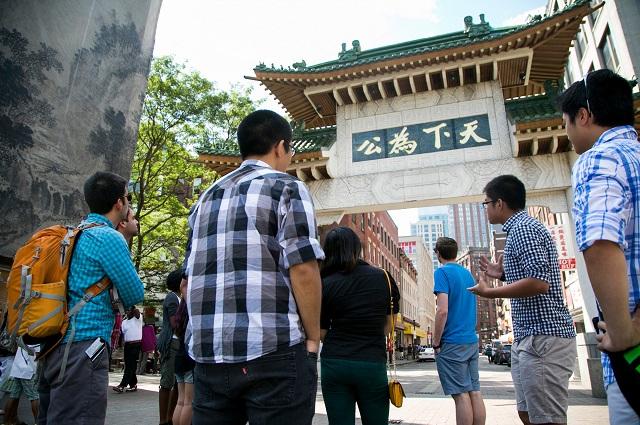Storytelling Links Community Research and Localized Action: Student Discussion with the Tisch College Community Research Center

Authors: Michelle deLeon (UMaine Orono), Leanne Loo (Tufts ’22), Elaine Donnelly (TCRC)
Two students from Tufts and UMaine led an exploratory discussion on how storytelling, embedded with significance across cultures, enhances research by centering community voices to aid our understanding of places and history. Led by Michelle de Leon and Leanne Loo, we learned about the value of storytelling practice through their collaborations with the Passamaquoddy Tribe community in Maine and Boston’s Chinatown neighborhood in Massachusetts. de Leon, a graduate student at UMaine, brought her experience with storytelling, community resilience, and environmental sciences to this conversation. Loo, an undergraduate student studying anthropology and public health whose interests in how power operates and how narratives are produced, reproduced, and silenced also shaped the discussion.
What is storytelling in research?
While there is no single definition of storytelling or of its place in research, the practice of storytelling can create critical space for participant leadership in data collection, analysis, and understanding. Storytelling in research seeks to include diverse voices in scientific processes, acknowledging that different perspectives can inform how researchers, practitioners, and community members approach messy community issues. As such, it incorporates multiple levels of roles (ex. speaker, listener) and power dynamics (ex. position of researcher, position of community participants). Storytelling asks community members and researchers alike to be vulnerable and to actively listen to one another. By recognizing the personal and political stakes in each narrative as it is shared, these stories themselves are an approach to research that centers community knowledge and meaning-making of community members’ experiences.
When does storytelling become a participatory research practice?
Storytelling becomes a participatory research practice when community voices help inform scientific processes and decision making. For example, what questions and projects are prioritized? How will issues and solutions be approached, and by whom?
Sometimes the practice of storytelling is helpful to be “research.” It lends credibility for researchers working with community members by building trust with them throughout the research process. Similarly, it also lends credibility for community members by allowing them space to make useful contributions to science. Moreover, storytelling can sometimes be unhelpful, like other CBPR and PAR practices, when projects and people do not fit well with the local context.
With these ideas, we understand storytelling to be a narrative (critical for community engaged research and activism), both as a tool for equity and justice (by centering community voice) and as a collaborative endeavor with multiple voices – which all reflect CBPR and PAR principles and practices.
Recently, we learned from two place-based and community-centered examples of storytelling:
Chinatown’s Immigrant Heritage Trail
A project under the Chinatown Community Land Trust, the Immigrant History Trail is a participatory placekeeping project seeking to uplift the diverse immigrant, working-class histories of the Chinatown neighborhood. Part of a larger resident and activist project for community control of development in Boston Chinatown without displacement amid increasing gentrification, the Trail centers the land and people, past and present, of this neighborhood. The volunteer team–comprising Chinatown activists, researchers, and community members–creates physical markers, including posters, stickers, road signs, and banners, that take the official historical plaque as a point of departure. These plaques ask those who see them to make a phone call. When the number is dialed, the caller will hear a story.
As a member of the team supported by a Tisch College Community Research Center student grant, Leanne shared her experience working on a subsection of the Trail focusing on histories of food and foodways, ranging from bootlegging in the 1920s to the oldest restaurant in Chinatown’s legacy in 2021. Reflecting on narrative, Leanne shared that narrative is not simply about what and when something happened, but also includes the people who were involved and the political and personal stakes. Storytelling can also be a research approach that centers community knowledge, for listening–a key part of storytelling–is not one-sided. Rather, storytelling is a co-constitutive project of creating and archiving knowledge.
Photo Credit: Noela Altvater
Supporting community resilience in Downeast Maine
Michelle de Leon, graduate student in Ecology & Environmental Sciences and participant in the NSF-Research Traineeship on Conservation Science, shared her collaborative work on storytelling with tribal members of the Passamaquoddy Tribe at Sipayik and their storytelling project.
The Sipayik Environmental Department (SED) and UMaine held 2019 community meetings where community members shared what they saw as priority social and ecological issues in their community. Following community input, SED identified four priority narratives and initiated an inter-organization team to tell these stories. On this team, tribal members craft the story with technical and administrative support from non-tribal members, like de Leon. She highlighted that she engaged as an active listener to stories and not as a facilitator. She leverages storytelling as a culturally relevant research method to engage ethically with the Passamaquoddy Tribe. de Leon recognizes her research partners’ indigenous cultural values, power, and voice and how their inclusion throughout the project adds depth to their collaborative work.
Courtesy of Noela Altvater
What does this project mean for action? The collaborative work centers indigenous diplomacy and invites the Passamaquoddy voice to the table, especially youth. Storytelling enables the Passamaquoddy tribal member to creatively present ongoing work on the reservation to address this issue, as well as her family’s personal experiences. Her StoryMap presents a richness of community voices through her inclusion of survey results and interviews. The storytelling project also creates space for Passamaquoddy tribal members to share everyday stories about being disconnected from leadership: not everyone in tribal leadership and in the community experience water issues in the same way. This project therefore shines an honest light on water issues and poverty in the community.
Conclusion
As the examples above illustrate, storytelling helps us make meaning of our lives and the world around us, elevating “ordinary” experiences to better understand our own communities. When shared beyond our communities, stories also help translate community knowledge and histories in relatable ways.
The storytelling projects in Boston’s Chinatown and downeast Maine illustrate how storytelling is more active than listening passively. It entails processes to recognize contextual information, reflect on one’s own experiences, and co-create knowledge and new actions in response to what the stories illuminate. Important issues surround this work such as concerns of intellectual ownership and how community knowledge is shared.
Power dynamics require ongoing attention and work, including self-accountability and intentional shifts in roles. Furthermore, recognizing that there are personal and political stakes for individuals sharing their stories is an essential guardrail to co-producing this work. Storytelling incorporates reflexive and reciprocal practices and is in many ways dependent on relationships; storytelling requires trust and respect. Researchers interested in storytelling, or storytellers more broadly, should recognize their positionality and relation to power. Researchers should ask: how do we show up? Who is the audience for these stories? Whose voice is amplified? And, how do we impact material change?
So how does one begin, especially as a student? deLeon and Loo advise that a good place to start is where one is right now, to understand storytelling work within our own local situation. For example, are you interested in climate campaigns? Take the global aspect of that work and reflect on it within local contexts, including one’s own role as a student or resident. There is no single way to do storytelling, but it is fundamentally grounded in respect for different perspectives. Ultimately, these projects teach us that the first step is actively listening, to grasp the many different perspectives of the “same” story across members of a community.
